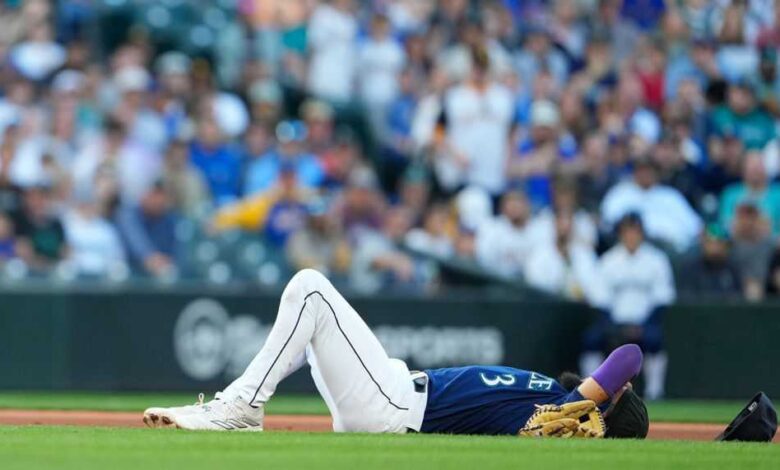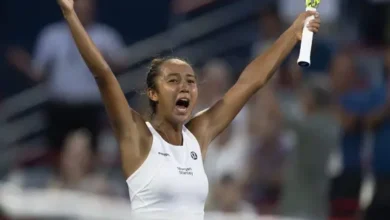
In the realm of professional sports, where the pursuit of excellence intersects with the unpredictability of competition, every season unfurls as a narrative woven with moments of triumph and tribulation. The 2023 campaign for the Seattle Mariners exemplifies this dynamic, characterized by dramatic victories and unforeseen challenges that test the mettle of players and organizations alike. Among the most poignant chapters of this narrative is the recent decision to place star shortstop J.P. Crawford on the 7-day concussion injured list—a move that not only impacts the Mariners’ performance on the field but also shines a light on the broader themes of player well-being, teamwork, and the resilience of the human spirit.
The incident that led to Crawford’s placement on the concussion injured list serves as a stark reminder of the physical demands and risks inherent in professional sports. During a pivotal game against the San Diego Padres, the fourth inning crystallized the high-stakes nature of the matchup. A sharply hit groundball set the stage for a collision that showcased the dedication and intensity of athletes committed to securing victory for their teams. The impact, however, left Crawford with a concussion—an injury that transcends the realm of sports and delves into the realm of health and safety.
Recognizing the gravity of head injuries, Major League Baseball has implemented protocols designed to protect players’ well-being. The 7-day concussion injured list, a central component of these protocols, mandates a period of rest and evaluation for players who have suffered head injuries. This approach ensures that players receive proper medical attention and have sufficient time to recover before returning to the field. The Mariners’ decision to place Crawford on this list demonstrates their commitment to adhering to these protocols, as well as their emphasis on the health and long-term prospects of their players.
The retroactive application of the injured list, effective from August 10th, illustrates the meticulous nature of the Mariners’ approach to managing player injuries. This decision showcases the organization’s dedication to thorough evaluation, ongoing monitoring, and a systematic reintegration process. The Mariners’ commitment to Crawford’s well-being extends beyond his immediate role as a player; it reflects their understanding of his value as an individual with aspirations and contributions beyond the realm of baseball.
Crawford’s absence reverberates through the Mariners’ lineup and defensive strategies. As a shortstop, he occupies a position that requires a unique blend of agility, quick decision-making, and leadership. Beyond the statistics, his influence extends to the team’s chemistry and morale. The challenge of compensating for his absence extends not only to tactical adjustments but also to the intangible elements that define a team’s cohesiveness.
In the grand tapestry of professional sports, challenges emerge as crucibles of character and resilience. The Mariners’ response to Crawford’s absence is a testament to their adaptability and the depth of their roster. Baseball, a game of strategy and unpredictability, demands a constant willingness to evolve and innovate in the face of adversity. The Mariners’ ability to pivot their strategies and rely on the collective strength of their players is a testament to their commitment to success.
Yet, beneath the surface of statistics and strategic decisions lies a narrative that resonates with audiences far beyond the realm of sports. J.P. Crawford’s journey from collision to recovery serves as a symbol of the human spirit’s capacity to overcome adversity. His unwavering commitment to returning to play not only inspires his teammates but also exemplifies the dedication and perseverance that define athletes in the face of challenges. Crawford’s journey underscores that sports, while a realm of competition, are also a canvas for stories of determination, unity, and hope.
As the Mariners navigate the remainder of the season, the countdown to Crawford’s return represents a beacon of anticipation and motivation. His triumphant reentry to the lineup will be a testament to his resilience and the collaborative effort of his teammates, coaches, and medical staff. It will embody the spirit of perseverance that defines athletes and serves as a source of inspiration for fans who witness the journey from injury to comeback.
In closing, the placement of J.P. Crawford on the 7-day concussion injured list is a chapter in the Mariners’ season that transcends the confines of baseball. It symbolizes the intersection of competition and compassion, strategy and empathy. The Mariners’ approach to Crawford’s injury is not just about wins and losses; it is a statement of their commitment to player welfare, their adaptability in the face of adversity, and their understanding of the power of resilience. As the Mariners continue their quest for excellence, they do so with the knowledge that the journey is defined by the collective stories of determination, unity, and the unwavering pursuit of success.
The broader context of Crawford’s injury extends beyond his individual experience. Across the sports world, concussions have become a topic of increasing concern due to their potential long-term effects on athletes’ health. In recent years, various professional sports leagues, including the NFL and NHL, have taken steps to improve the diagnosis, treatment, and prevention of concussions. Research into the long-term effects of head injuries has led to greater awareness and changes in how these injuries are managed.
The Mariners’ decision to prioritize Crawford’s well-being is part of a broader trend in sports that emphasizes player safety. This approach not only aligns with ethical considerations but also recognizes the long-term viability of athletes’ careers. Teams and organizations now understand the importance of providing proper medical care, rehabilitation, and support to players who face injuries. This, in turn, contributes to the overall health of the sport and fosters a positive public image for both the team and the league.
Crawford’s journey from collision to recovery is a testament to the multidimensional nature of resilience. It’s not just about physical healing; it’s also about mental and emotional fortitude. Athletes like Crawford often face challenges beyond their injuries, including doubts, fears, and pressures to perform at the highest level upon their return. The mental strength required to overcome these obstacles is a reflection of the athlete’s determination and the support network they have around them.
In the modern age of sports, where media coverage is extensive and fan engagement is high, the story of a player’s injury and subsequent comeback resonates deeply with the audience. It humanizes the athletes, making them relatable figures who face adversity like anyone else. Crawford’s journey becomes a narrative that transcends the boundaries of a single team and transforms into a universal story of hope and perseverance. Fans from all walks of life find inspiration in the dedication and grit displayed by athletes like Crawford.
The impact of Crawford’s absence on the Mariners’ lineup and performance highlights the intricate balance that exists within a sports team. Each player contributes not only with their physical skills but also with their presence, attitude, and influence on team dynamics. The absence of a key player like Crawford requires the team to recalibrate its strategies, both on and off the field. Teammates must step up to fill the void, and coaches must devise new approaches to maintain the team’s competitive edge.
Beyond the tangible effects, there’s an intangible aspect to Crawford’s role within the team—the leadership he provides. Leadership on a sports team isn’t solely about seniority; it’s about qualities that inspire and motivate others. Crawford’s dedication, work ethic, and passion for the game set an example for his teammates. In his absence, other players may find themselves stepping into leadership roles, which can have a lasting impact on their personal growth and the team’s future dynamics.
As the Mariners press forward in the 2023 season, the management of Crawford’s injury becomes a strategic puzzle. When will he return? How will
his absence and subsequent return impact team performance? These questions are part of the larger game within the game—the strategic planning and decision-making that often goes unnoticed by fans but plays a crucial role in shaping the outcome of a season. The Mariners’ coaching staff and analysts work tirelessly to analyze data, assess player progress, and make informed choices that optimize the team’s chances of success.
Looking beyond the present season, the story of Crawford’s injury and recovery becomes a chapter in the broader narrative of his career. Athletes frequently encounter setbacks and obstacles that test their resolve. Crawford’s journey, while challenging, is likely to contribute to his personal growth and development as a player. It’s not uncommon for athletes to emerge from such experiences with a newfound perspective, a deeper appreciation for the game, and a heightened sense of determination.
In the digital age, where social media and online platforms dominate communication, the connection between athletes and fans has evolved. Fans have unprecedented access to players’ lives, thoughts, and experiences through various online channels. This connection creates a unique opportunity for athletes to share their journeys, including the hurdles they face and the triumphs they achieve. Crawford’s openness about his recovery process can inspire fans who may be dealing with their own challenges, fostering a sense of community and mutual support.
The Mariners’ handling of Crawford’s injury showcases the collaboration that takes place within a sports organization. It’s not just about the players and coaches; it’s also about the medical staff, trainers, and various support personnel who play vital roles behind the scenes. The collective effort to ensure Crawford’s full recovery speaks to the interconnected nature of the sports industry. The dedication of these professionals contributes to the overall success of the team and the well-being of the players.
In the broader context of sports history, stories like Crawford’s injury and recovery become part of the legacy of the game. Throughout history, sports have been marked by legendary comebacks, iconic moments, and instances of resilience that capture the imagination of fans for generations. These narratives become part of the fabric of sports culture, passed down through anecdotes and retellings. Crawford’s journey will join the ranks of such stories, serving as a source of inspiration for future athletes and fans alike.
In conclusion, the placement of J.P. Crawford on the 7-day concussion injured list is not just a footnote in the Mariners’ 2023 season; it’s a chapter that resonates with the essence of sports itself. It embodies the collision of dedication and challenge, teamwork and individuality, competition and compassion. The Mariners’ response to Crawford’s injury reflects their commitment to his well-being, their adaptability in the face of adversity, and their understanding of the significance of resilience. As the Mariners continue their pursuit of excellence, they do so with the understanding that the journey is composed of the collective stories of determination, unity, and the relentless pursuit of success.



